My Brain Event as a Jump-Cut
I haven't directly blogged about this topic before, but on July 1, 2008, right after I finished the final draft of my novel Hylozoic, I had a hemorrhagic stroke. This meant that a blood vessel in the right half of my brain had suddenly burst. The fact that it was prone to bursting was in the nature of a birth defect, a booby-trap that had been waiting for 62 years. I kind of prefer the euphemism "brain event" for it.
Fortunately I didn't suffer any really dire consequences like paralysis or speech-slurring. For me, the most disturbing thing about the experience was in some sense philosophical. When I awoke in the hospital, I had no sense at all of any intervening time period. And that still bothers me. The interval when I'd been unconscious was like a jump-cut. Bam. And it seemed fairly clear that it would have been entirely possible to never wake up at all.
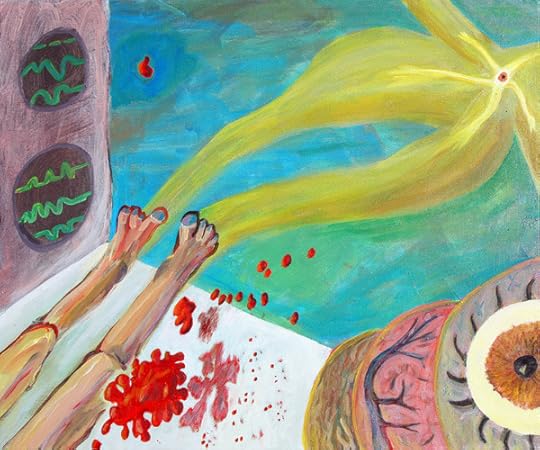
A couple of months afterwards, on September 12, 2008, I made a painting called, "Cerebral Hemorrhage." I wasn't quite that bad off, but it almost felt that way. I like the 3D blob of blood and its shadow on the sheet, also the way the guy's soul is flowing out through the soles of his feet…with the lobes of his brain piled up on the right like a compost heap, with a terrified, watchful eye on top, twinned with the eye in that starfish-shaped soul.
And I started writing about the stroke that fall in what turned into two books. The first is my autobiography, Nested Scrolls, which starts out with the stroke.
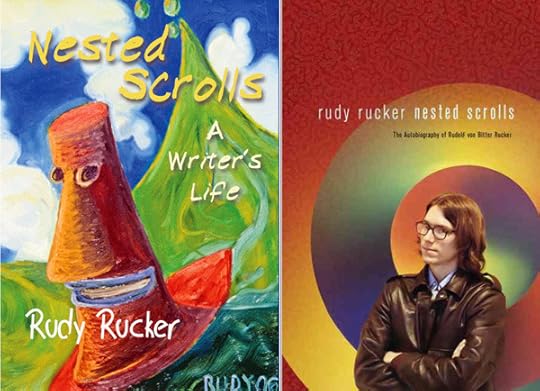
Conditioned by a zillion novels and movies, you tend to think of death as a big drama—with a caped Grim Reaper kicking in your midnight door. But death may be as ordinary as an autumn leaf dropping from a tree. No spiral tunnel, no white light, no welcome from the departed ones. Maybe it's just that everything goes black.
In those first mornings at the hospital, I'd sit on their patio with an intravenous drip on a little rolling stand, and I'd look at the clouds in the sky. They drifted along, changing shapes, with the golden sunlight on them. The leaves of a potted palm tree rocked chaotically in the gentle airs, the fronds clearly outlined against the marbled blue and white heavens. Somehow I was surprised that the world was still doing gnarly stuff without any active input from me.
As I slowly recuperated in July and August of 2008, I started writing in my journal, and then in a Notes document. At that point I wasn't yet sure whether I was planning to write a memoir or a novel.
One the one hand, my brush with death had made it very clear that, if I was ever going to write an autobiography, the time was now.
On the other hand, my trains of thought were running very loopy, and it seemed like it might be entertaining to use the stroke as an event in a transreal novel, possibly a novel involving the afterworld.
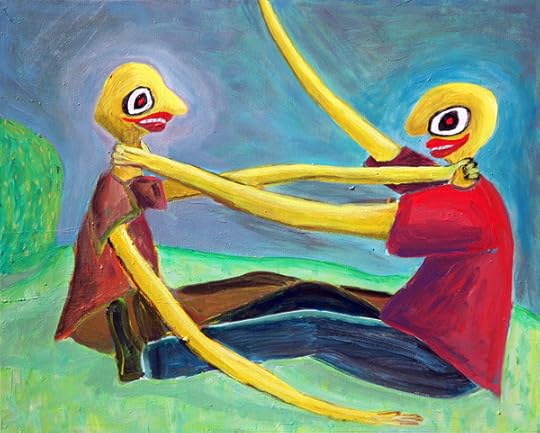
I actually did a painting before "Cerebral Hemorrhage." This one, finished July 21, 2008, is called "Collaborators." I went out to some en plein air painting with my friend Vernon. We were bickering a little about whether or not I'd picked a good spot.
I started out with an image of two painters, and then I had them start choking each other. As I really don't have any strong hard feelings towards Vernon, I'd say that what I was really depicting is the stroke itself as an external being attacking me. Choking me around the neck. It's not so uncommon in dreams, or in adventure movies, to have a hero and his demon/double get into a choking contest.
But then I remembered that right before my stroke I'd just finished a rather bruising round of revisions on a story I was co-writing with Bruce Sterling—our fifth short story, "Colliding Branes," which appeared in Asimov's in 2009. So it oddly amused me to tell Bruce, who I love, that my attack of "apoplexy" was his fault for being so intransigent and argumentative. He'd pushed me over the edge. He'd nearly killed me. Not falling for the guilt trip, Bruce imperturbably replied that I wouldn't have any further problems if I would just accept that he was always right. Actually, our sixth collaboration, "Good Night Moon", in 2010, went much smoother. I'd accepted that Bruce was often (if not always) right.
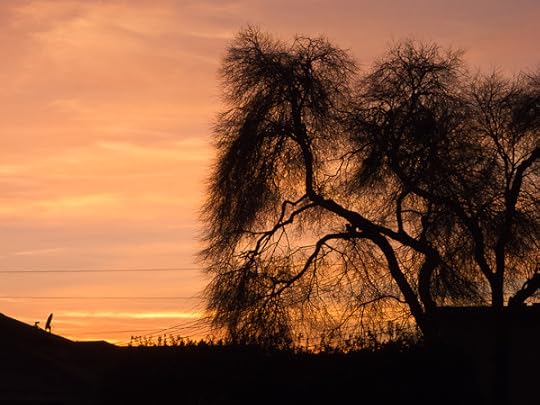
One of the things bothering me was that I wasn't feeling as if I had an eternal soul. As I wrote in my journals on July, 20, 2008.
I have a new sense of seeing the street scene without "me" at the center. I used to see the world as if it had a big reflecting ball in the middle, the ball being me and my feelings. But this week it feels like the ball is gone. I'm just seeing a lawn with people. I'm not there at all, or I'm much smaller than before. It's like there's a hole in the scene.
I express a related idea in Nested Scrolls.
I think this was when I finally came to accept that the world would indeed continue after I die. Self-centered as I am, this simple fact had always struck me as paradoxical. But now I understood it, right down in my deepest core. The secrets of the life and death are commonplace, yet only rarely can we hear them.
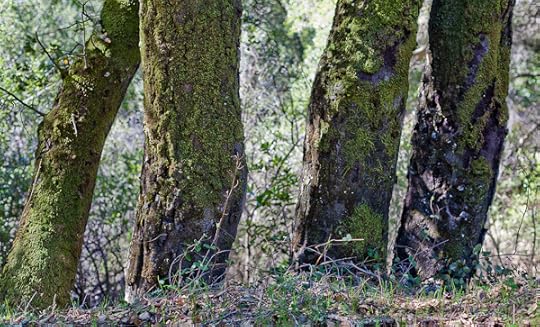
As you can see from a blog post of mine, "Teeming Tales," by August 4, 2008, I'd pretty much decided to write a novel in parallel to my memoir. Although I had less reason than ever to believe in an actual afterworld, but this only meant that I had more of a reason than ever to fantasize about life after death. Fantasy and science-fiction novels are, after all, to a large degree instruments for authorial wish-fulfillment. You write about the kinds of worlds that you wished you lived in. And I wished more than ever that I lived in a world where there was an afterworld—call it Flimsy.
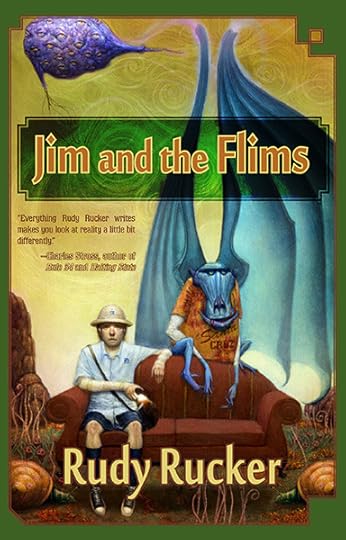
Some of the stroke material ended up in my novel Jim and the Flims.
I vegged out on my dusty Goodwill couch, reading a paperback fantasy novel. It was a peaceful summer afternoon, with the sunlight lying across the roof and yard like heavy velvet.
After awhile I began having the feeling that I could read the pages of the book without actually looking at them. But I was having trouble making sense of what I read. Thinking I needed a nap, I laid down my book and curled up on my side. I dropped off to sleep.

The next thing I knew, I was lying on the living room floor, very confused. It was dark outside. I felt like I'd been—gone. I ached all over, in every muscle and joint. My tongue was bleeding. Something very bad was happening to me.
I crawled across the room to where my cell phone sat with my keys. I didn't trust myself to walk. It took all my concentration to dial 911. And then everything went black again.
I awoke in a hospital room. It was still night. A nurse was standing over me, a woman with a calm, sympathetic face. She said I'd had two seizures. They weren't sure why. Maybe I'd be okay. They had me on an IV drip with painkillers and an anti-seizure drug. I needed to rest.
I slept fitfully. In the morning I was able to think a little. I could hardly believe I was in the hospital. How disturbing to think that I'd been to death's door and back. I hadn't seen any white light or spiral tunnel or dead relatives while I'd been out—none of that cool, trippy stuff. I'd been nowhere and I'd seen nothing. It just felt like I'd had a couple of time-sequences snipped out of my life. Discouraging.
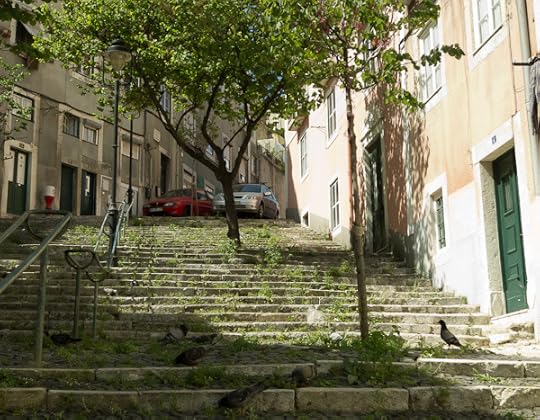
Two final remarks. First of all, I'm happy to report that I'd made a full recovery from that July 1, 2008, brain hemorrhage by the fall of 2008. I got off easy. I went back to life as usual—writing books, going on trips with my wife, making visits with the kids, writing blog posts. Regular life is such a sweet and wonderful thing.
A second point. It feels like ever since I had my brain hemorrhage, people have been telling me to watch Jill Bolte Taylor's TED video talk "A Stroke of Insight". So today I finally did.
And it's really a lovely talk. She's a great speaker, very emotional, funny at times, and with an uplifting message: stay in touch with your non-linear, mystical right brain. The way she gets from the stroke to the message is that the blood vessel that burst in her brain happened to be in the logical, left hemisphere. And it didn't immediately knock her out. So she had a few minutes more or less like an acid trip, in which she was seeing the world through the right brain.
In my case, the blood vessel burst in the right half of my brain, and I almost immediately blacked out. For me it wasn't like like an acid trip, it was a jump cut. Bam, everything black, then you're awake. And at some point, Jill hit the jump-cut, too, although she doesn't talk about it very much. It's sort of negative and disturbing thing. And people don't really want to think about that. They want to push that aside and think about the insight and the high. Let them.

I'm all for living in my right brain and being in touch with the cosmos at large. I was just now outside in our garden watching the fat bumblebees on our salvia flowers. Right-brain joy.
But I'm living in the fairly sure and certain knowledge that at some moment in my future, it's all going to stop. Bam. And I more or less have to be okay with that. If I worry about it, the fear poisons my life. If I accept it, I can enjoy what I have left. More flowers, food, family, and writing. It's good while it lasts. For that matter, it's a miracle and a blessing that we get any life at all.
Rudy Rucker's Blog
- Rudy Rucker's profile
- 583 followers




